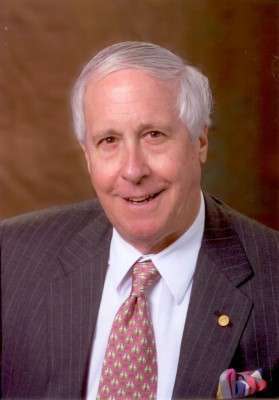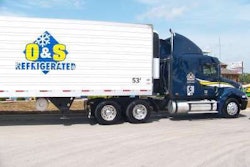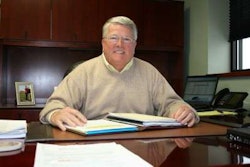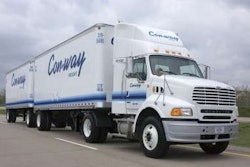 Albert Evans, Jr., president and CEO of The Evans Network, spearheaded the company's green initiatives and load-matching concept for container traffic at ports.
Albert Evans, Jr., president and CEO of The Evans Network, spearheaded the company's green initiatives and load-matching concept for container traffic at ports.In 2008, the ports of Los Angeles and Long Beach launched a program to reduce emissions that included a phaseout of older trucks and concession agreements for trucking companies serving the ports. Urged on by labor unions, the Port of Los Angeles permitted only trucks operated by company drivers to perform port container drayage service. The American Trucking Associations didn’t object to the phaseout, but it is challenging the ban on independent contractors and other aspects of the two ports’ concession agreements.
So far, ATA is winning in the courts on the most important issues, but the attempt to change the status of port owner-operators on the grounds of environmental policy was a wakeup call to executives of The Evans Network of Companies. The Schuylkill Haven, Pa.-based company relies mostly on owner-operators to serve ports on the East Coast from Boston to Ft. Lauderdale, Fla.
Seeing Southern California as a warning sign, The Evans Network in 2008 began focusing on reducing emissions by company and independent contractor equipment at ports it serves by working with U.S. Environmental Protection Agency and nongovernment organizations to line up grants and other support for upgrades, says Gerard Coyle, vice president of marketing and agent development.
But the new environmental focus also led The Evans Network to efforts to reshape how it dispatches and operates equipment. A new program called Export Coordination/Optimization-Match, or ECO-Match, aims to cut emissions and shipping costs by reducing the number of trucks needed for pickup and delivery of containers.
“The primary benefit for shippers and steamship lines is the cost savings by using one truck rather than two,” Coyle says.
Cutting emissions
The Evans Network is comprised of six affiliates that provide intermodal container and trailer drayage, van truckload and flatbed transportation services. Altogether, The Evans Network operates a combined fleet of 1,350 tractors and 80 service centers, and generates more than $185 million in revenue annually.
About 100 of the trucks operated by The Evans Network are company-owned, and those became the first target for fuel efficiency improvements. Through a number of steps including driver training and monitoring, reduced speed, idle cutoffs and use of auxiliary power units and bunk heaters, the company boosted mpg by about 30 percent in a year, Coyle says. For its efforts, The Evans Network received the highest possible score of 1.25 in EPA’s SmartWay Transport Program.
Through its affiliates Century Express and Evans Delivery Co., The Evans Network also was among the first companies to participate in the Virginia Port Authority’s “Green Operators” pilot program, which arranges low-cost financing to retrofit exhaust filters to provide vehicles with more emissions-efficient engines. The company is splitting the cost of the filters for its contractors with the Virginia Department of Environmental Quality via EPA’s National Clean Diesel Program.
Executives are discussing further initiatives with VPA to enhance the GO program – for example, giving drivers a separate gate entrance to expedite traffic, reducing congestion and emissions further. The Evans Network also is submitting grant proposals to retrofit vehicles with filters at four additional ports on the East Coast.
“We are trying to help ports meet some of their goals and raise awareness of what technology you can use that will work to reduce air pollution at ports,” Coyle says.
Maximizing container capacity
In 2007, ports in the United States handled 22 million containers, few of which were matched up on a roundtrip basis by importers and exporters, Coyle says. Drayage carriers typically move import and export containers between ports and destinations with freight only in one direction. As it began to focus on ways to become more efficient, The Evans Network estimated that matching just 25 percent of these shipments overall would eliminate more than 4 million roundtrips and 4 billion pounds of carbon dioxide emissions per year, and save 175 million gallons of fuel.
“Unfortunately for us and the population in general, the whole container drayage business is not on the radar screen of the EPA and SmartWay,” Coyle says. To date, big domestic shippers that participate in EPA SmartWay have not focused their emissions efforts on the import side of their businesses, he says. “We are trying to create some awareness of that end of the business.”
To that end, the company launched its ECO-Match program with a goal to match up to 75 percent of the import and export shipments handled by The Evans Network by making more productive use of resources.
“As an example, by matching just 20 percent of container movements at the Ports of Virginia, the ECO-Match initiative has the potential to save 73.6 million pounds of CO2 annually,” says Albert Evans Jr., president and chief executive officer of The Evans Network.
Steamship lines and other customers often lack communication and visibility between even their own import and export departments, Coyle says. For example, the same customer’s import department will order a roundtrip pickup and delivery of a container from the port of Charleston, S.C., to Charlotte, N.C. The same customer’s export department will call later the same day to order a one-way container pickup and delivery from Charlotte to Charleston.
The Evans Network has begun talking to customers about execution strategies and making the drayage industry aware of the opportunity to improve its shipment scheduling and communications. The company first approached one of its import customers, clothing manufacturer Phillips Van Heusen, about matching shipments from the Port of New York to central Pennsylvania with shipments from metal scrap dealers that export shipments out of central Pennsylvania through the New York port. The company also has spoken with Waste Management Recycle America, which exports 17,000 containers a year through ports on the East Coast.
ECO-Match is as much an industry initiative as it is internal, Coyle says. Executives for the Evans Network have spoken with EPA, with customers and at industry conferences such as the Mid Atlantic Clean Ports Workshop in Philadelphia. “This is something we need people to get behind,” he says. “Our goal right now is to make people aware.”
The number of shipments matched in The Evans Network today is small, Coyle says. “It’s a more complex problem than it appears on the surface because there are a number of important issues to consider, such as equipment compatibility, timing schedules, geography and technology.” Reaching the goal of 75 percent will require a lot of participation by steamships, 3PLs, importers and exporters.
Coyle has spoken with several nongovernment organizations that are interested in working with The Evans Network to develop load match optimization software that could determine the least-cost roundtrips that make sense for multiple importers and exporters.
“You have got to have someone say, ‘We are going to start doing this and putting the technology in place.’ Because of Bert Evans driving this initiative, we’re out in front of people,” Coyle says. “We are assuming that other trucking companies will get on board.”











